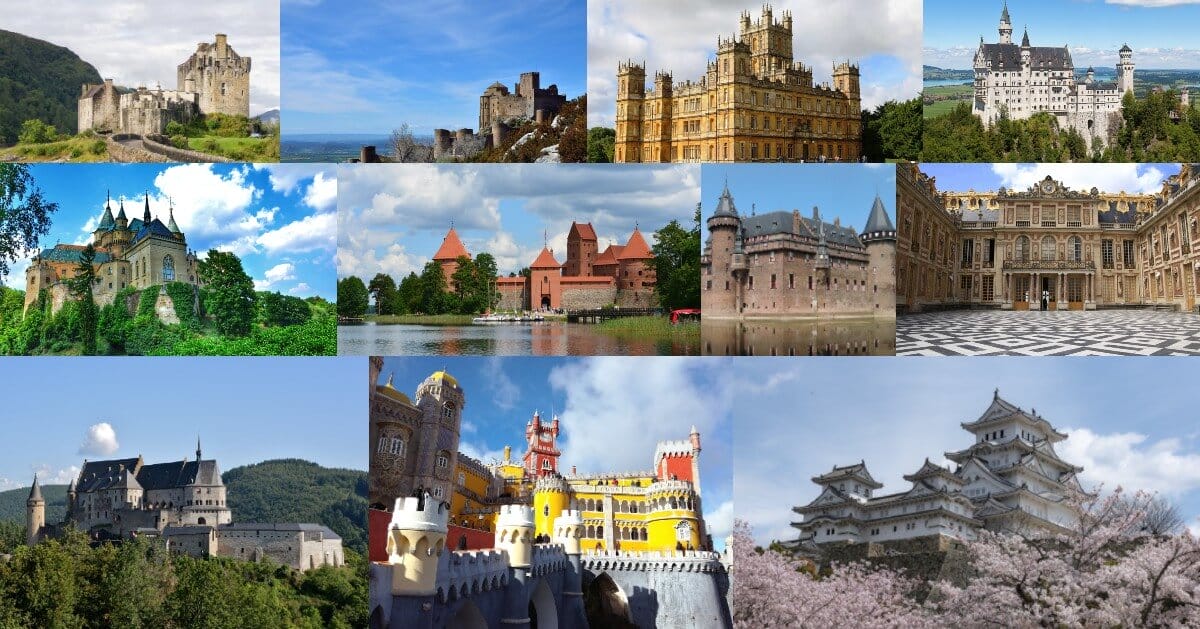Article
Discovering the most beautiful castles of the cinema

Palace of Versailles (France)

Built in 1623, the Palace of Versailles has undergone until 2017 multiple expansion, renovation and beautification. It was the main residence of the French kings Louis XIV, Louis XV and Louis XVI. Known throughout the world, Versailles inspires and fascinates. Spread over 815 hectares, it includes the Petit and Grand Trianon, the Queen’s hamlet, an orangery and its famous Hall of Mirrors. In the cinema, he appeared many times as for example in 1927 in Napoleon, in 1965 in Angelique and the King, in 1988 in Valmont or The King’s Daughter in 2016. In total, more than 218 shootings took place within the walls of the most famous of castles. No doubt, this is Versailles.
Neuschwanstein Castle (Germany)

Visited each year by more than a million tourists, Neuschwanstein Castle is the most famous in Germany. Built in 1869, it is surprisingly contemporary. It owes its foundations to the ruins of an ancient castle, Hohenschwangau, and its construction by King Ludwig II of Bavaria. Sadly famous for having been used as a Nazi depot for works looted in France, it is nonetheless a fairy tale castle. And for good reason, the building inspired the castle of Sleeping Beauty of Disney.
Bojnice Castle (Slovakia)

The first mention of a stronghold in this place dates back to the 12th century. At that time, Bojnice was part of a group of 30 castles built to defend the border. The building belonged to the same family, the Pálffy, from 1643 to 1918. Every year, a festival of ghosts and monsters is held there. The places themselves have a reputation for being haunted. For Batman fans, a huge cave full of bats was discovered under the castle in the 1950s. The whole, including the cave, is open to visitors. In addition to this singular reference to the Black Knight, the castle has hosted the cameras of Alisea and the Dream Prince in 1996 and World Without End in 2012.
Trakai Castle (Lithuania)

Built in the 14th century, Trakai Castle was of great strategic importance at that time. Recognizable by its red bricks, the building welcomes visitors and offers a huge museum on the history of Lithuania. Coins, stamps, maps and other archaeological remains are on display. The place has hosted the cameras of Blood of the Templars in 2004, Dungeons & Dragons: Wrath of the Dragon God in 2005 or Highlander: The Source in 2007.
Eilean Donan Castle (Scotland)

Located on a small Scottish island, Eilean Donan Castle is considered the most romantic castle in Scotland. Built at the beginning of the 13th century, it has been damaged and rehabilitated many times. Almost the entire castle is open to the public and has been voted the most beautiful castle in Scotland on numerous occasions. It is also possible to reserve the premises for a wedding or photography sessions. It is also widely open to filming as evidenced by its long list of productions, each more prestigious than the last. Among them are Highlander in 1986, The World is Not Enough in 1999 and Elizabeth: The Golden Age in 2007.
Loarre Castle (Spain)

Built in the 11th century, the castle is one of the most beautiful examples of Spanish fortifications and is in a remarkable state of conservation. It is one of the best examples of military and civil architecture in Europe. These different qualities have allowed it to reach the rank of national monument in 1906 and is part of the tentative list of the UNESCO world heritage in the category “cultural heritage”. It was used for the filming of The Dark Night of the Soul in 1989, Kingdom of Heaven in 2005 and Antigona despierta in 2014.
Himeji Castle (Japan)

Built between 1581 and 1618, the incredible Himeji Castle is one of the oldest buildings in medieval Japan. It is a national treasure of the country and a UNESCO World Heritage Site, and is remarkably well preserved. It is one of the last twelve Japanese castles whose wooden keep is still completely authentic. Its location and condition make it one of the most filmed castles. Among the feature films shot here are You Only Live Twice in 1967, Kagemusha in 1986, Ran in 1985 and The 47 Ronins in 1994.
Highclere Castle (England)

Built in 1839 in the neo-Jacobean style, Highclere Castle is one of England’s most popular film locations. The historic residence of the Earls of Carnarvon, Highclere Castle was designed by Charles Barry, the architect of the Palace of Westminster. It is located on a site that once housed an episcopal palace and an Elizabethan-style mansion. It is from the latter that the architect designed the new building, which he wanted to be the most grandiose of the castles.
Surrounded by three lakes and numerous cedars of Lebanon arranged in a remarkable garden, the monument also includes the table and chair used by Napoleon during his first abdication on Elba. Many Egyptian antiquities are exposed in the basement. In the cinema, we can admire him in The Missionary (1982), King Ralph (1991), Eyes Wide Shut (1999), The Four Feathers (2002) and the two films from the Downton Abbey series.
De Haar Castle (Netherlands)

A castle occupied the site in the 14th century. But this building is much more recent, dating from 1892. The first fortress has suffered the ravages of battle and time. In 1641, it gradually fell into ruins. In 1890, Etienne Gustave Frédéric baron van Zuylen van Nyevelt van de Haar inherited the castle. A few years earlier, he had just married Baroness Hélène de Rothschild. The couple proceeded to the reconstruction of the house. 200 rooms, 30 bathrooms, 7,000 trees, the place is equipped with all the modern comforts of the time. Since 2011, the castle has been owned by the Kasteel de Haar Foundation, which regularly organizes fairs and markets on these grounds. Stricken (2009) and Sinterklaas & Diego: Het geheim van de ring (2014) were filmed there.
Castle of Vianden (Luxembourg)

The origins of the castle of Vianden can be traced back to the 5th century. Most of the existing buildings were built between the 11th and 14th centuries. Subject to numerous modifications and restorations, it is now the property of the Luxembourg government. It was the scene of a battle between the Luxembourgers and the Germans during the Second World War, which resulted in a retreat by the Germans, who were far superior in numbers. The place is open to visitors and overlooks the eponymous city. The enclosure of the fortification has hosted the filming of Sherlock Holmes and the Leading Lady in 1991, D’Artagnan in 2001 or Les Chevaliers du Roi in 2008.
National Palace of Pena (Portugal)

Located in the heart of a 200-hectare park in Sintra, the National Palace of Pena stands out for its bright colors and neo-Romantic architecture. Built in 1838 by Ferdinand II of Portugal, the building became, since the proclamation of the Republic in 1910, the property of the State. It is open to the public and the visit is colorful. It is not strictly speaking in the category of castles but it is undoubtedly an exceptional site. In the cinema, we can admire the palace in Daughter of Dracula of 1972 or Love Letters of a Portuguese Nun released in 1977.
The Fantrippers Buying Board

By Damien Duarte
Passionné par la culture pop depuis son enfance, ses références vont de Donald Duck à Batman en passant par Marty McFly. Fantripper dans l'âme, voyager sur les traces de Ghostbusters, James Bond ou des héros de romans comme Cotton Malone fait partie d'un séjour idéal et réussi !





